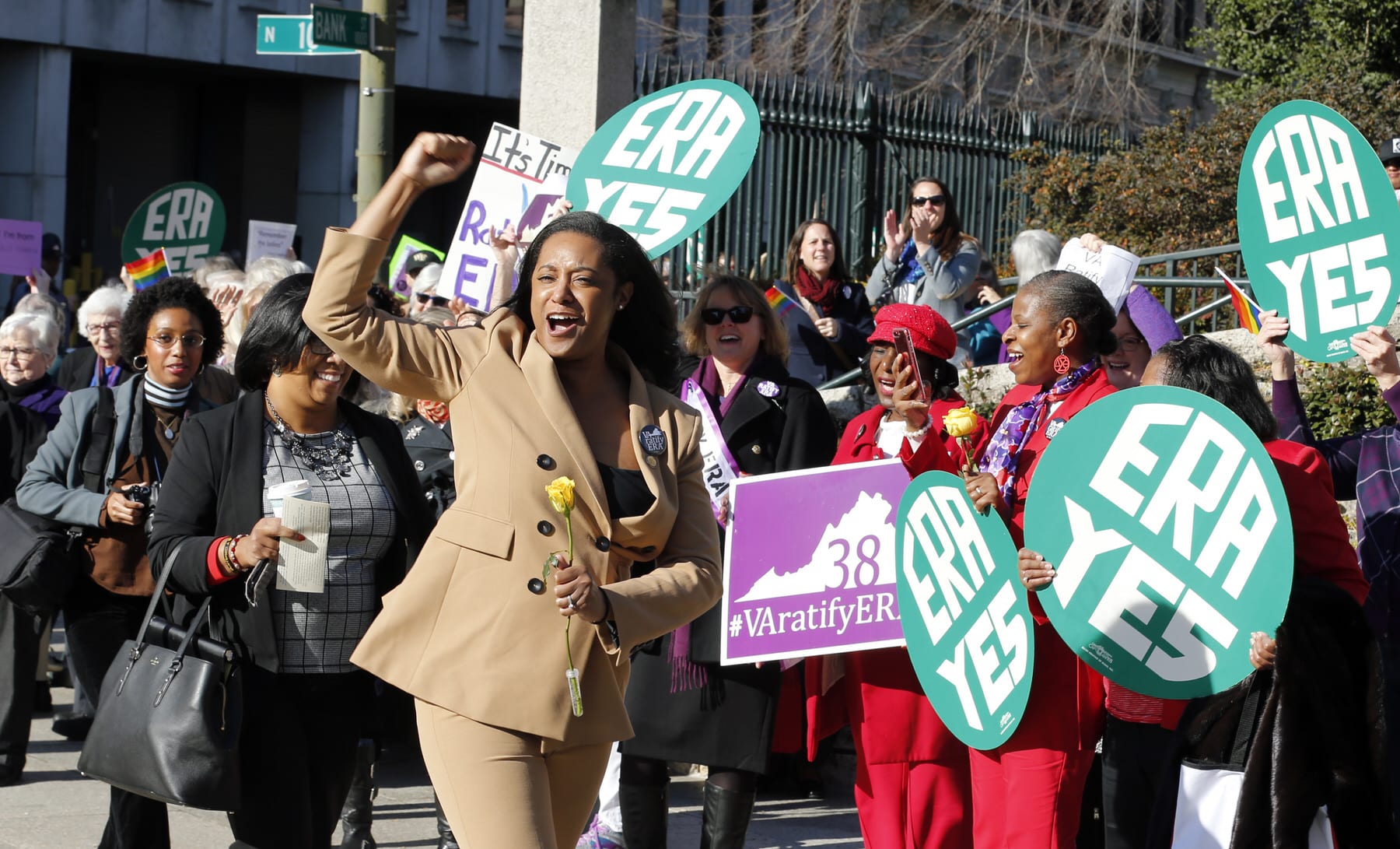In 2015, Nevada state Sen. Pat Spearman got the Equal Rights Amendment before a legislative committee.
That’s as far as it got that year, though. There just wasn’t enough support from state lawmakers on the committee to take it up for a vote.
Spearman remembers one older woman approaching her after it became clear that the state’s ratification of the amendment — which would explicitly state in the U.S. Constitution that discrimination on the basis of sex is prohibited — wasn’t going anywhere.
“She came to me, tears dripping down her face,” Spearman said. “She’s crying and she’s just kind of shaking. She grabbed my hand and she said, ‘Senator, I thought I would see this in my lifetime. I don’t know how long I can hang on.’ I said, ‘Hang on, we’re going to get it done.’”
A renewed effort to ratify the Equal Rights Amendment was brewing in state legislatures by then. In 2011, the Virginia Senate had passed a resolution to ratify the amendment, but it didn’t have enough support in the state House. In 2014, the Illinois Senate passed a similar resolution, but it also lacked enough support in the other chamber.
Each passing year seemed to improve the political winds. Spearman successfully helped lead an effort in 2017 in the Nevada legislature to ratify the ERA. It was the first statehouse to do so in 40 years, becoming the catalyst for ratifications in Illinois in 2018 and Virginia in 2020. Those states became the final ones needed to add the amendment to the Constitution, though what that actually means remains unclear.
“What I’m doing is what our foremothers prayed for,” Spearman said. “It didn’t happen in their lifetime. But they worked very hard to make sure that there was enough of this fight for equality left, so they could hand it off to the next generation.”
That next generation is predominantly Black women, women of color and LGBTQ+ people. Spearman, a Black queer woman, is among a group of state lawmakers around the country who sought to get enough support to ratify an amendment that its supporters believe is still needed to address glaring disparities in areas like compensation, child care access, pregnancy protections, and domestic and sexual violence. While sex discrimination protections have been expanded by court rulings over several decades, legal experts say there are still gaps.
“When we retire, that’s when you really see more women retire in poverty than men,” said Spearman, a Democrat who has been vocal about addressing pay inequities. “And that is even worse for Black women. So that is what the ERA is about.”
The increase in racial and gender diversity in statehouses appears to have made a difference in the fight for acknowledging the Equal Rights Amendment.
A judge this month dismissed a lawsuit that sought to recognize the amendment, a setback for supporters but one they say is not fatal. They believe the next steps fall on Congress. The U.S. House is set this week to take up a resolution that would recognize the ERA. It is expected to pass but faces a more uncertain future in the nearly evenly split Senate.
“I think it’s fair to say that at least the resurrection movement of the 21st century really would not have succeeded without the leading role of Black women” and other women of color, said Julie C. Suk, author of “We The Women: The Unstoppable Mothers of the Equal Rights Amendment.”
In Virginia, a multigenerational group of Black women lawmakers led the ratification of the ERA in January 2020: state Sen. Jennifer McClellan, state Sen. Mamie Locke and then-state Del. Jennifer Carroll Foy. Other key lawmakers in Virginia during ratification were Del. Hala Ayala, an Afro-Latina woman now running for lieutenant governor, and Del. Danica Roem, the first out transgender woman to be elected and seated in a state legislature.
“The fact that Virginia was the 38th state and that it was led by Black women is poetic justice,” McClellan said. “And the fact that we did it on the 100th anniversary of the 19th Amendment is poetic justice.”
For Carroll Foy, now a former lawmaker (she and McClellan are both seeking the Democratic nomination for governor), the opportunity to fight for equality at the legislature was personal.
Carroll Foy was one of the first Black women to graduate from the Virginia Military Institute, which opened its doors to women after the Supreme Court in 1996 struck down the school’s men-only admission policy. Then-Justice Ruth Bader Ginsburg wrote the majority opinion that is considered a landmark ruling on sex discrimination.
Carroll Foy sees a correlation between the increased diversity of statehouses and the more recent ratifications of the ERA. The Virginia legislature had more women than ever before when she and others helped ratify the amendment, and the ERA became an issue on the campaign trail for many candidates.
“You always see different priorities and policies being passed when you have different people at the table,” she said.
Kate Kelly is a human rights attorney and activist who supports the ERA and wrote an amicus brief in legal proceedings aimed at recognizing it. She said marginalized people repeatedly call out inequality because it is so often a part of their daily lives. Given their platforms in statehouses, it’s no surprise they’re using their political power to enact change.
“In addition to the fact that Black women and women of color legislators are incredible and courageous and clear-minded and powerful and for all these other reasons, they also can see the problem,” she said.
Decades of work by women, both White and non-White, as well as others, went into the push for the ERA, Suk said. (The 19th has expanded on the history of the fight over the Equal Rights Amendment here.) But after the 1982 extension by Congress expired and only 35 states had ratified the amendment, many supporters thought it was lost.
Spearman didn’t think so. A new Democratic majority in the statehouse (which included an increase in women) gave the amendment new life in 2017. Between the work of Spearman and state lawmakers like state Sen. Nicole Cannizzaro (now the first woman majority leader for the chamber) and Yvanna Cancela (a state senator who recently stepped down to work for the federal government), the legislature approved ratification. Suk noted the support of Republican women along the way like state Sen. Heidi Gansert. The way Spearman sees it, there is no expiration on equality.
“You’re either going to be on the right side of history, or you’re going to be standing on the sidelines while we make history,” she said.
In Illinois a year later, Black lawmakers including state Sen. Kimberly Lightford, then-state Rep. Litesa Wallace and then-state Rep. Juliana Stratton, now the state’s lieutenant governor, helped get the amendment through. Black women like state Rep. Mary Flowers and state Rep. Rita Mayfield also expressed opposition during debate in the state, in part because they weren’t sure how it would help Black women.
Mayfield, as Suk wrote in her book, argued the amendment, “does not in any way, shape or form benefit a woman of color,” pointing to her belief that it would overturn affirmative action programs, though many legal experts disagree.
Flowers told The 19th that she can’t ignore the racism of the women’s suffrage movement and how it left Black women and women of color behind. She believes it’s more effective to focus on immediate policies, especially around maternal health, to help Black women.
“It’s symbolic,” Flowers said of the amendment. “The ERA is not going to put more food on a person’s table. It’s not going to give them a better education … I’m not trying to put anyone down if the ERA is what they want. But don’t look to me to put myself down in order to build you up. I’m not going to do that.”
But for many Black women and women of color, the work isn’t done, including in Arizona, Arkansas, Florida, North Carolina, South Carolina and Utah. They’re still leading efforts to ratify the amendment, part of an effort to address concerns about states that attempted to rescind their ERA ratifications decades ago.
The complexities of what comes next if the Equal Rights Amendment is added to the Constitution is important, said McClellan in Virginia. Like other ERA supporters, she doesn’t believe the amendment will be some kind of switch; it is aimed at directing legislators to enact future policy with a focus on equality. She predicts that will be led by Black women and women of color.
“You get the ERA ratified, and then you begin the work of changing laws, and changing the impact those laws have had on making women second-class citizens,” she said. “And just like we didn’t give up in the civil rights movement, we’re not going to give up in the women’s rights movement.”
There is also a generation of Black women, women of color and LGBTQ+ people who are grassroots organizers reaching out to Congress and introducing the ERA to new audiences.
Carol Jenkins, CEO and president of the ERA Coalition and Fund for Women’s Equality, is one of them. A Black woman, she is leading key groups to lobby members of Congress to remove a deadline added to the amendment when it was first adopted in 1972. At that point, the deadline was seven years; later it was extended for three more.
“We understand more than most what the discrimination feels like,” said Jenkins about the significance of marganilized voices in the fight for the Equal Rights Amendement. “I think they get it. I think they understand that the persistence of inequality through years and years — 100 years when this effort began — is alarming. I think they understand that we have to get this done.”






